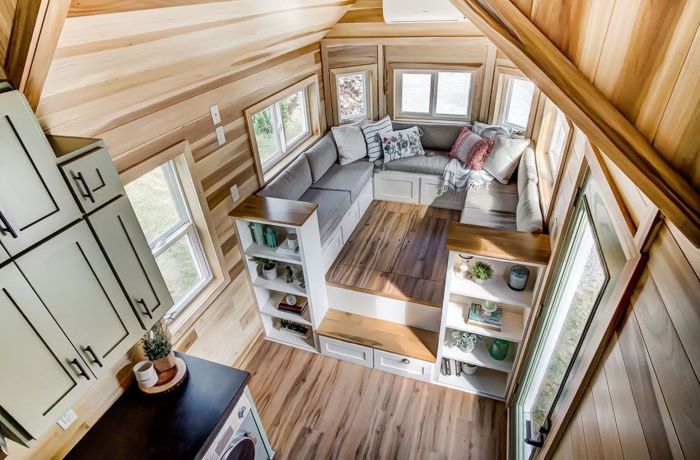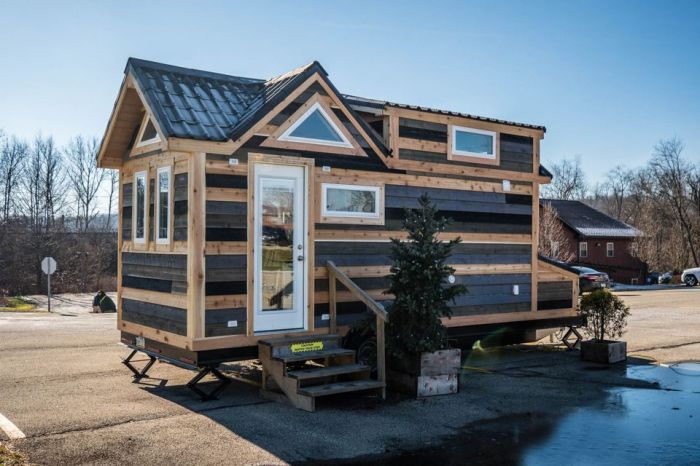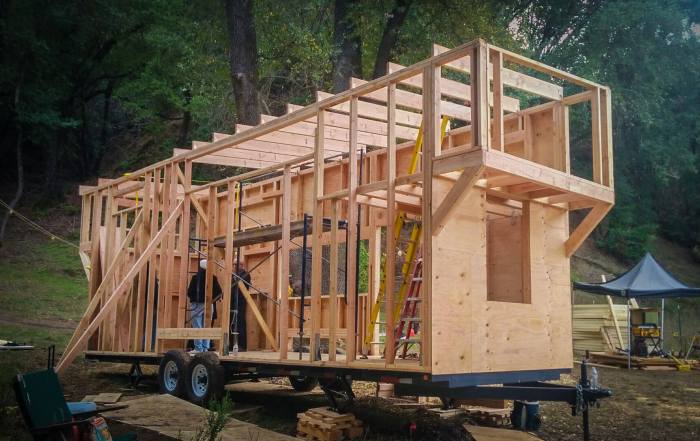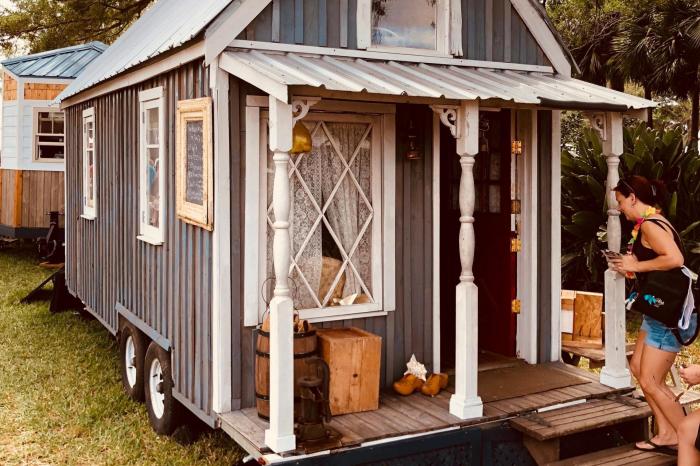Embrace a simpler, more sustainable lifestyle with our comprehensive guide to designing your own tiny house. This detailed plan walks you through eight crucial steps, from initial planning and sustainable material selection to interior design optimization and practical building considerations. Learn how to maximize space, minimize clutter, and create a comfortable, eco-friendly home perfectly suited to your needs.
We’ll cover everything from crafting a functional floor plan for a 200 sq ft space to installing plumbing and electrical systems while adhering to safety regulations. Discover innovative storage solutions, sustainable building materials, and practical tips for decluttering and minimizing possessions. Whether you’re a seasoned DIY enthusiast or a complete beginner, this guide provides the knowledge and resources you need to embark on your tiny house journey.
Planning Your Tiny House

Designing and building a tiny house requires careful planning to ensure functionality, structural integrity, and sustainability. This involves considering the foundation, overall design, material selection, and integration of sustainable features. A well-planned tiny house maximizes space and minimizes environmental impact.
Floor Plan for a 200 sq ft Tiny House
A 200 sq ft tiny house necessitates a thoughtful layout to accommodate essential living spaces. The following table Artikels a possible floor plan, keeping in mind the need for efficient use of space and ease of movement. Remember that these are approximate dimensions and can be adjusted based on personal preferences and specific building materials.
| Room | Length (ft) | Width (ft) | Area (sq ft) |
|---|---|---|---|
| Kitchen | 8 | 6 | 48 |
| Bathroom | 4 | 4 | 16 |
| Living Area | 10 | 8 | 80 |
| Sleeping Loft | 10 | 8 | 80 |
| Total | 224 |
Note: The slight discrepancy in total area is due to the simplification of dimensions and the exclusion of wall thickness.
Structural Considerations for a Tiny House on a Trailer
Building a tiny house on a trailer requires careful consideration of weight distribution and stability. The entire structure needs to be designed to withstand the forces of travel and to remain stable when parked. Uneven weight distribution can lead to instability and damage to the structure and the trailer. A common approach is to create a robust frame that evenly distributes the weight across the trailer’s axles. The use of lightweight yet strong materials is crucial to minimize the overall weight and maximize stability. For example, a well-designed frame using engineered lumber can significantly improve structural integrity without excessive weight. Regular maintenance of the trailer and its components, such as the axles and tires, is essential to ensure long-term safety and stability.
Sustainable Building Materials for Tiny Houses
Several sustainable building materials offer cost-effective and environmentally friendly options for tiny house construction. Reclaimed wood, for instance, reduces deforestation and offers a unique aesthetic appeal. Its cost can vary greatly depending on availability and condition, but it often presents a more economical option than newly harvested lumber. Bamboo, a rapidly renewable resource, provides exceptional strength and flexibility, making it a suitable choice for framing and flooring. While its initial cost might be slightly higher than traditional lumber, its durability and sustainability justify the investment. Straw bales, a readily available agricultural byproduct, offer excellent insulation properties and contribute to reduced carbon footprint. However, they require specialized construction techniques and may not be suitable for all climates. The selection of building materials should consider local availability, cost, and the specific climate conditions to optimize both sustainability and cost-effectiveness.
Exterior Design Incorporating Sustainable Features
Imagine a tiny house clad in reclaimed cedar siding, its warm brown tones complemented by large, energy-efficient windows. The roof, slightly sloped to maximize rainwater harvesting, is fitted with solar panels seamlessly integrated into the design. A small, strategically placed rainwater collection system directs water to a storage tank, reducing reliance on municipal water supplies. The exterior is designed to be both aesthetically pleasing and environmentally responsible. The use of natural materials, like the cedar siding, minimizes environmental impact while providing a visually appealing finish. The integration of solar panels and a rainwater harvesting system showcase the commitment to sustainable living. Vertical gardens on the exterior walls can further enhance the visual appeal and provide additional environmental benefits by improving air quality and reducing the urban heat island effect.
Interior Design & Space Optimization for Minimalist Living

Designing the interior of a tiny house requires a strategic approach to maximize functionality and comfort within a limited space. Careful planning and the selection of multi-functional furniture are key to achieving a truly minimalist and efficient living environment. This section will explore various design strategies to optimize space and create a welcoming atmosphere in your tiny home.
Multi-Functional Furniture Layout for a Tiny House Living Room
A well-designed living room in a tiny house needs to seamlessly integrate seating, storage, and potentially even sleeping arrangements. Each piece should serve multiple purposes to avoid clutter and maximize the limited square footage.
- Sofa Bed: A sofa bed serves as comfortable seating during the day and a sleeping space for guests or occasional use. Imagine a sleek, modern sofa bed with built-in storage underneath for blankets or pillows.
- Ottoman with Storage: An ottoman provides extra seating and can double as a coffee table. Opt for one with a lift-top to reveal hidden storage for books, games, or other items.
- Wall-Mounted Shelves: Instead of bulky floor-standing units, wall-mounted shelves maximize vertical space and offer storage for books, decorative items, and other essentials. Consider open shelving for a light and airy feel, or closed cabinets for a more streamlined look.
- Fold-Down Desk: A fold-down desk attached to the wall can be easily folded away when not in use, freeing up valuable floor space. This is ideal for working from home or pursuing hobbies.
Storage Solutions for a Tiny House Kitchen
Kitchen storage in a tiny house necessitates creative solutions to keep the space organized and efficient. Vertical space is your best friend.
- Pull-Out Drawers: Maximize drawer space by installing pull-out drawers that allow easy access to all items. This is far more efficient than deep cabinets.
- Vertical Spice Rack: A narrow, vertical spice rack mounted on the wall saves counter space and keeps spices easily accessible.
- Stackable Containers: Use stackable containers for pantry items to make the most of vertical space in cupboards and shelves.
- Magnetic Strips: Magnetic strips on the wall or inside cabinet doors provide a space-saving solution for storing knives and other metal utensils.
- Under-Cabinet Storage: Install drawers or shelves under cabinets to make use of otherwise wasted space.
Creating a Relaxing and Comfortable Sleeping Space in a Tiny House Loft
The loft in a tiny house is often the primary sleeping area. Creating a relaxing atmosphere here is crucial for quality sleep.
- Adequate Lighting: Incorporate a combination of ambient lighting (overhead lighting or soft wall sconces) and task lighting (a bedside lamp) for reading or other activities. Consider using dimmable LED lights for versatility.
- Ventilation: Good ventilation is essential to prevent stuffiness. A small window or skylight, combined with a ceiling fan, will help to circulate air and maintain a comfortable temperature.
- Comfortable Bedding: Choose high-quality, comfortable bedding that is appropriate for the loft space. Consider the size and shape of the bed and mattress to maximize available space. A platform bed or a Murphy bed might be ideal space-saving solutions.
Decluttering and Minimizing Possessions Before Moving into a Tiny House
Downsizing is a critical step before moving into a tiny house. A thorough decluttering process is essential for a successful transition to minimalist living.
- Inventory Your Belongings: Begin by making a comprehensive inventory of everything you own. This will help you visualize the scale of your possessions.
- The 20/20 Rule: If an item can be replaced for under $20 within 20 minutes, consider getting rid of it. This helps to eliminate unnecessary duplicates or easily replaceable items.
- The One-Year Rule: If you haven’t used an item in the past year, it’s likely you don’t need it. Donate, sell, or discard these items.
- Categorize and Purge: Organize your belongings into categories (clothing, books, kitchenware, etc.) and systematically go through each category, discarding anything you no longer need or use.
- The Four-Box Method: Use four boxes labeled “Keep,” “Donate,” “Sell,” and “Trash” to sort your belongings efficiently.
Building & Living in Your Tiny House

Embarking on the construction of your tiny house requires careful planning and execution, encompassing various practical considerations that range from installing essential utilities to navigating legal requirements. This section will guide you through the process, offering insights into construction methods, safety regulations, and the legal landscape of tiny house living.
Plumbing System Installation
Installing a plumbing system in a tiny house necessitates meticulous planning and adherence to safety regulations. Begin by designing a layout that efficiently utilizes space and minimizes pipe runs. Consider using PEX tubing for its flexibility and ease of installation. All connections must be properly sealed to prevent leaks. Remember to install a water heater appropriate for the size of your tiny house and ensure adequate ventilation to prevent carbon monoxide buildup. Local plumbing codes must be strictly followed, and inspections are usually required before occupancy. Failure to comply can result in significant penalties and safety hazards. For example, improper venting can lead to dangerous gas accumulation, while faulty connections can cause water damage and mold growth.
Electrical System Installation
Similar to plumbing, installing the electrical system requires careful planning and adherence to local electrical codes. A qualified electrician should be consulted, especially for complex wiring configurations. Proper grounding is crucial for safety, preventing electrical shocks. The use of GFCI (Ground Fault Circuit Interrupter) outlets in areas prone to moisture, such as bathrooms and kitchens, is mandatory in most jurisdictions. Adequate wiring capacity is essential to prevent overloading and potential fires. An electrical panel with sufficient breakers should be installed to accommodate the electrical needs of your appliances and lighting. Remember to obtain the necessary permits and inspections to ensure compliance with building codes. A poorly installed electrical system poses serious risks, including electrical fires and electrocution.
Tiny House Construction Methods: DIY vs. Professional Building
The choice between a DIY approach and hiring a professional builder significantly impacts the construction process, budget, and outcome. A DIY approach offers cost savings and the satisfaction of building your own home, but requires considerable time, skill, and knowledge of construction techniques. Potential setbacks include delays due to lack of experience, potential errors leading to costly repairs, and the risk of injuries. Conversely, hiring a professional builder guarantees expertise, efficiency, and adherence to building codes, minimizing risks and ensuring a higher quality build. However, this option comes at a higher cost. Weighing the pros and cons carefully, considering your skills and budget, is crucial for making the right decision. For instance, a novice might find framing the walls manageable, but electrical and plumbing work might require professional assistance.
Legal and Regulatory Aspects of Tiny House Ownership
Owning and living in a tiny house often involves navigating unique legal and regulatory challenges. Zoning regulations vary significantly between municipalities, with some outright prohibiting tiny houses on wheels or requiring specific lot sizes. Building permits are generally required, even for smaller structures, and may involve inspections at various stages of construction. Compliance with local building codes is essential, covering aspects such as structural integrity, fire safety, and sanitation. Additionally, consider property taxes and homeowner’s insurance, which may be affected by the unique nature of tiny houses. Thorough research into local regulations and consultation with relevant authorities is crucial to avoid legal issues and ensure a smooth process. For example, a tiny house on wheels might be considered a recreational vehicle in some areas, subject to different regulations than a permanently affixed structure.
Essential Tools and Materials Checklist
Proper planning and preparation are crucial for a successful tiny house build. Organizing your tools and materials by construction phase simplifies the process and minimizes delays.
- Foundation Phase: Leveling tools, gravel, concrete, post hole digger (if applicable), pressure-treated lumber.
- Framing Phase: Measuring tape, saw (circular, hand), hammer, nails, screws, lumber (framing, plywood), drill, level, framing square.
- Sheathing & Roofing Phase: Plywood, roofing materials (shingles, metal), roofing nails, staple gun, safety harness.
- Insulation & Finishing Phase: Insulation (batt, spray foam), drywall, paint, trim, flooring materials, lighting fixtures.
- Plumbing & Electrical Phase: PEX tubing, fittings, water heater, electrical wiring, outlets, switches, electrical panel.
Conclusion

Building your own tiny house is a rewarding journey that combines creativity, practicality, and a commitment to minimalist living. By following the steps Artikeld in this guide, you can design and construct a space that perfectly reflects your lifestyle and values. Remember, the key is careful planning, sustainable choices, and a focus on maximizing the functionality of your limited space. Embrace the challenge, and enjoy the process of creating your own unique and fulfilling tiny home.